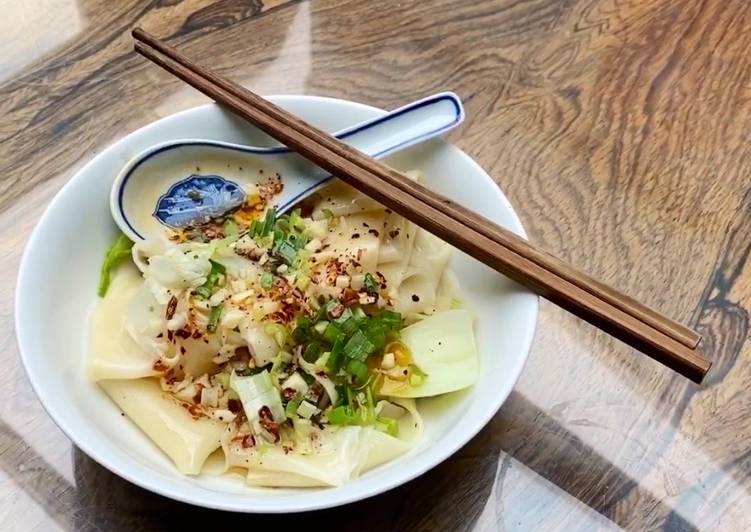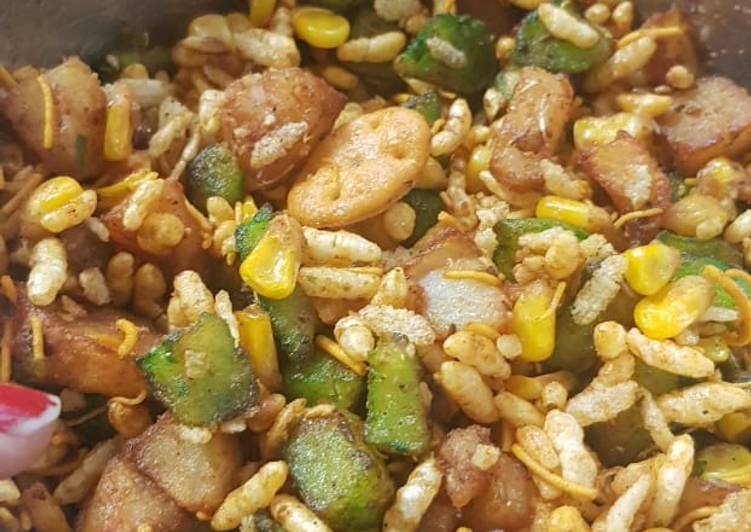
Hello everybody, it is me, Dave, welcome to my recipe site. Today, I’m gonna show you how to make a special dish, biangbiang mian/noodles (handpulled noodles). One of my favorites. This time, I will make it a little bit tasty. This will be really delicious.
Biangbiang mian/noodles (handpulled noodles) is one of the most popular of recent trending meals on earth. It is appreciated by millions daily. It’s simple, it’s quick, it tastes delicious. They’re nice and they look wonderful. Biangbiang mian/noodles (handpulled noodles) is something which I’ve loved my whole life.
Using both hands carefully pull both ends of a flat piece out and swing it up and down making it thinner and thinner. Hand-pulled noodles (also known as la mian 拉面) are homemade noodles that are springy, chewy, comforting and so delicious. These traditional noodles are made with dough that is rolled and stretched into long strips, either thin or wide. Black vinegar is a dark vinegar made from glutinous rice or sorghum.
To begin with this recipe, we have to prepare a few ingredients. You can have biangbiang mian/noodles (handpulled noodles) using 20 ingredients and 13 steps. Here is how you cook that.
The ingredients needed to make Biangbiang mian/noodles (handpulled noodles):
- Get For the noodle dough:
- Make ready 300 g pasta or plain flour
- Make ready 1/4 teaspoon salt (use more or less depending on preference)
- Prepare 130 ml water (use more or less depending on flour)
- Take Oil for coating noodles:
- Get 1/4 cup vegetable oil, to coat the fresh noodles (use more or less depending on quantity of noodle)
- Make ready Cooking the noodles:
- Prepare 5 cups (boiled kettle water)
- Prepare 1/3 cup water, cold
- Prepare Blanching the vegetable:
- Make ready 2 pak choi, stems into wide strips and leaves into finer strips
- Prepare Assembling the noodles:
- Prepare 2 garlic clove, finely minced or grated
- Make ready 1-2 spring onion, finely sliced
- Make ready 1-2 teaspoons chili powder
- Take pinch salt, for each serving
- Prepare 2-3 teaspoons light soy sauce serving (add more or less depending on preference)
- Make ready 1-2 tablespoons black rice vinegar per serving (add more or less depending on preference)
- Take Hot oil:
- Take 2-3 tablespoons vegetable cooking oil, per serving
Biangbiang mian/noodles (handpulled noodles) is one of the most. What are hand-pulled noodles As its name suggests, hand-pulled noodles are formed by pulling wheat flour dough by hand into long, elastic strips. Compared to hand-cut and machine-made noodles, they usually have a more silky, springy and chewy texture. They are always served super fresh as the pulling and cooking process happens at the same time.
Instructions to make Biangbiang mian/noodles (handpulled noodles):
- To make the noodle dough in a large bowl, mix salt with flour. Then add water and stir bit by bit. Using either an electric mixer with a dough hook attachment to mix or if by hand using chopsticks. Tip: add the required water amount first to see whether the dough forms and is kneadable. If not add a tiny drop more water at a time until the dough forms a ball.
- Continue kneading the dough until smooth. Cover the noodle dough with cling film and let it rest for 20 minutes.
- Then after 20 minutes knead the dough again, until the surface is really smooth. This will make the dough easier to work with later and make it very pliable when stretching the dough to make the noodles. Cover the dough again with cling film and let it rest for another 20 minutes.
- In a small bowl pour the vegetable oil. In a medium size baking tray lightly coat and brush with vegetable oil. Remove the noodle dough from the mixing bowl and place on a chopping board. Weigh the dough and cut into two equal halves. Using the first half of the dough cut the dough into 6 portions, cover the other half with cling film (to prevent it drying out). There will be 12 noodle logs in total.
- Shape each one portion into a long log and brush all over with oil. Repeat the process for the second half of the dough. Once all the noodle dough have been shaped and oiled, cover with cling film. Let the noodle log rest for at least 1 hour or until ready to use. Tip: If making the noodles in advance put the noodle log into the fridge and take out an hour before use to let the noodles come to room temperature.
- In a large saucepan pour in the boiled water. On medium heat, bring water to a boil. In the meantime take one noodle log out and place it on a clean flat surface or on a large silicone mat.
- Flatten it and using a rolling pin roll out side ways to make the dough wider (make it as wider as per preference) and then roll out into a wide rectangle. Using chopsticks press it into the middle of the dough to indent it. Tip: this makes it easier to separate the noodles later.
- Then gripping and holding the two ends of the noodle strip slam the noodle dough against the silicone board flat surface This creates the smacking sound. While smacking the noodle dough slightly stretch it during the smashing process. This will make the noodles long. Tip: Stretch out the noodles slowly to prevent breakage.
- Once noodles are at desired length, separate noodles along from the chopstick trace. Tip: separate the noodles all the way to have two noodle pieces or partially separate but don't rip one end to have one long noodle. Repeat the process until you have the desired amount for that portion. I usually cook 6 strands at a time. Then separate noodles per portion in the bowls. Tip: If making it for a large family double the portion size. Have two pots of water on the go so you can cook more at once.
- Go back to the pot of boiling water and add the stems of the pak choi. Once they are half way cooked, add in the noodles. Once water boils again add cold water. And then add the leaves of the pak choi to blanch. Once noodles are cooked transfer the noodles and vegetables into a bowl.
- In the meantime, on medium to high heat in a pan or pot add 2 vegetable oil and heat it up until slightly smoky (this makes 1 serving). Turn off the heat.
- Then place as little or as much of the garlic, green onion and chilli powder on top on top of the noodles and pour the hot oil over the noodles (mainly over garlic, spring onions and chilli powder). Lastly, add soy sauce and black vinegar and mix well. Repeat process 6 to 12 for the remaining servings.
- Eat and serve immediately while the noodles are pipping hot. Tip: this batch should make enough for anyone that fancies a second round of biang biang noodles.
Compared to hand-cut and machine-made noodles, they usually have a more silky, springy and chewy texture. They are always served super fresh as the pulling and cooking process happens at the same time. As the birthplace of the modern noodle, Chinese chefs were pulling them by hand long before machines arrived, and in this class noodle diva Michelle Nguyen will have you stretching and slapping Biangbiang mian noodles in your own home kitchen. Biang Biang Noodles Be the first to rate & review! For Jing Gao, owner of the cult Sichuan food company Fly by Jing, making these fresh hand-pulled noodles, doused in garlic, ginger, chile, and.
So that is going to wrap it up with this special food biangbiang mian/noodles (handpulled noodles) recipe. Thanks so much for your time. I am sure that you will make this at home. There’s gonna be more interesting food in home recipes coming up. Don’t forget to bookmark this page on your browser, and share it to your loved ones, friends and colleague. Thanks again for reading. Go on get cooking!

